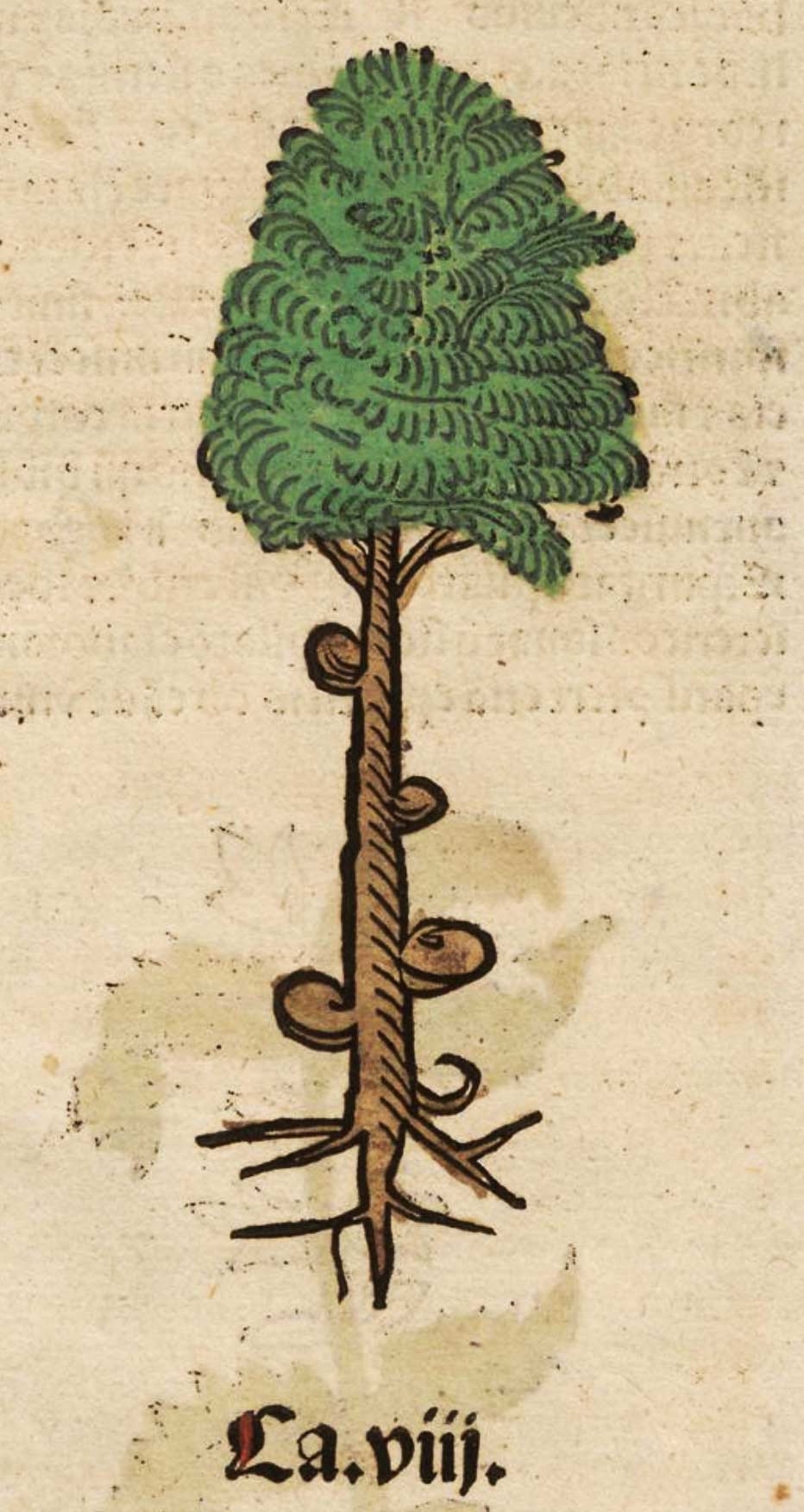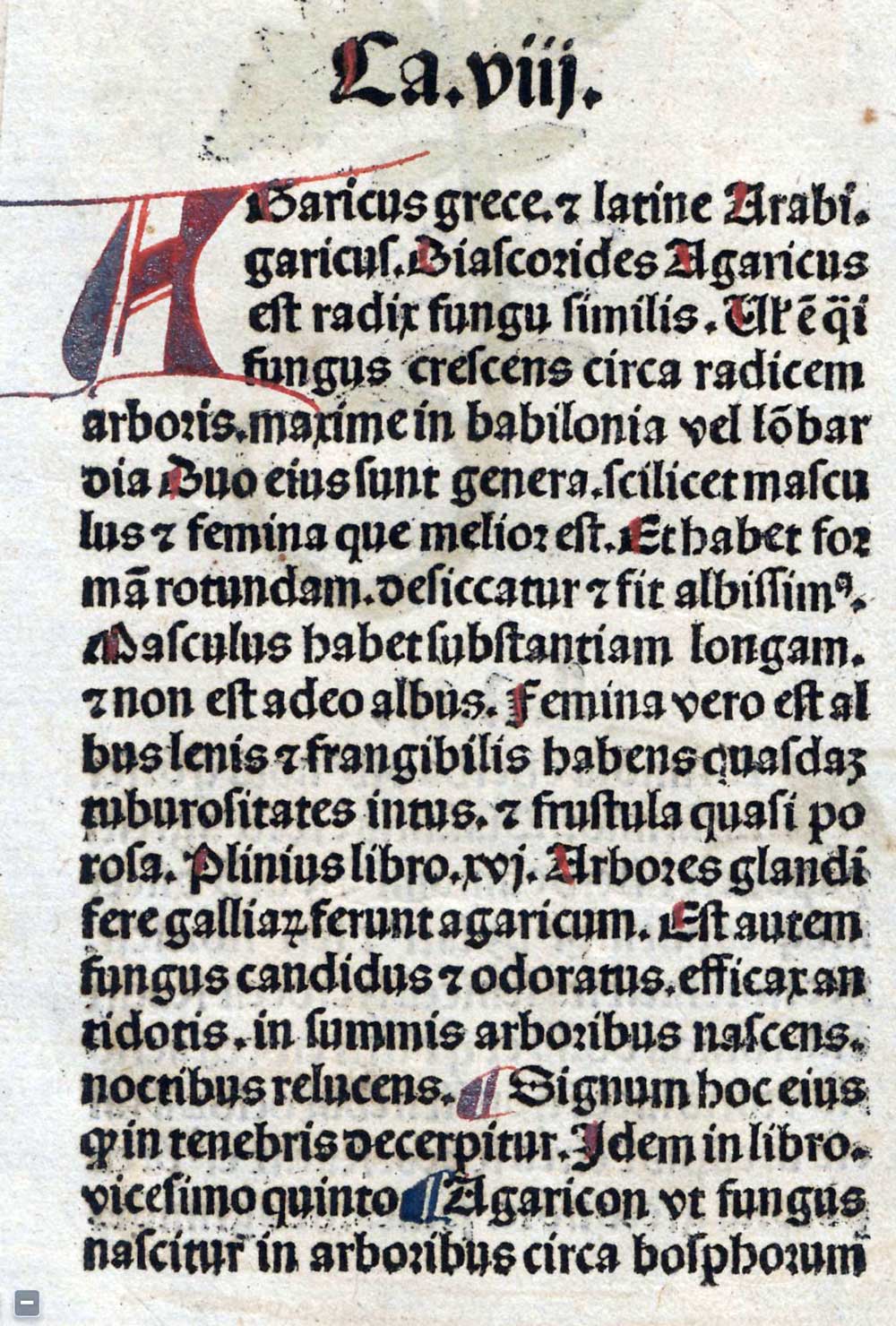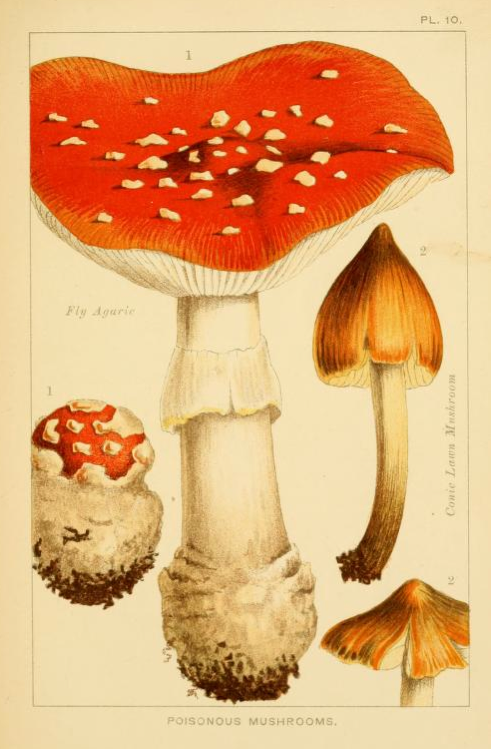Some relationship to Piémont, a recurring allusion in these chapters.
Agaric is also mentioned in Chapter 49, among the plants that have two sexes.
Notes
agaric
Les agarics se reproduisent ay moyen de spores exogènes, développées à la surface de certaines cellules des lames de l’hyménium, nommées basides. Il n’y a point chez eux de reproduction sexuée. (Paul Delaunay)
Agaricus
Agaricus (text)
Fly Agaric
the good Agaric
“Galliarum gladiferae maxime arbores agricarum ferunt. Est autem fungus candidus, odoratus, antidotis efficax, in summis arborius nascens, nocte relucens” (Pliny xvi. 8, § 13).
Agaric
Galliarum glandiferae maxime arbores agaricum ferunt; est autem fungus candidus, odoratus, antidotis efficax, in summis arboribus nascens, nocte relucens: signum hoc eius quo in tenebris decerpitur.
In the Gallic provinces chiefly the acorn-bearing trees produce agaric [A species of non-edible Fomes], which is a white fungus with a strong odour, and which makes a powerful antidote; it grows on the tops of trees, and is phosphorescent at night; this is its distinguishing mark, by which it can be gathered in the dark.
Agaric
Agaric blanc, Polyporus officinalis Fries (Basidiomycétes, Polyporées). Ce champignon croît sur les troncs de sapin et de mélèze dans les Alpes et le Dauphiné. Le parasitisme de l’Agaric sur le mélèze est également noté par Séb. Munster et par Belon (De arb. conif., f° 26). bien que ce dernier le dise rare. Lémery réserve à l’Agaric du mélèze le nom d’Agaric femelle. C’est le seul que l’on ait employé et que l’on emploie encore en matière médicale. (Paul Delaunay)
Melze
Meleses estants si frequentes au territoire d’Embrum & autout de Morienne, ne donneront despense à recouurer. Elles ont leurs semences plus petites que Cyprés, tant en la pommette que au noyau, toutesfois chasque chartée sur le lieu, qui l’entreprendoit, ne cousteroit pas un sou. C’est sur celuy dont la Manne est cueillie, & la grosse Terebenthine & l’Agaric aussi, & dont l’arbre est autant frequent es montaignes des Grisons, nommez en Latin Theti, qu’il fut onc, & es mesmes endroicts dont Tibere Empereur en feit apporter à Rome pour refaire le pont Naumachiarius, qui auoit esté bruslé.
larege
«Larege, Un arbre retirant à un Pin ou Sapin, Larix laricis. Les Venitiens l’appellent Larege, les Montagnars le nomment Melze», écrit Nicot. Sur l’agaric, voir Pline, XXV, 9, et Ruellius, De natura stirpium III, 1 : ce champignon était utilisé en médecine. La résine de mélèze est décrit par Pline, XVI, 10, et vantée par Galien, De compositione medicamentorum per genera, I, 12. Le «miel du ciel», ou «manne», qui, à l’aube, degoutte notamment sur les feuilles de mélèze, est examiné par Langius, Epistolae medicinales, LXIV. L’incombustibilité du mélèze est assurée par Pline, XVI, suivi par un foule d’auteurs.
agaric
Agaricum ut fungus nascitur arboribus circa Bosporum colore candido. dantur oboli quattuor contriti cum binis cyathis aceti mulsi. id quod in Gallia1 nascitur infirmius habetur, praeterea mas spissior amariorque2—hic et capitis dolores facit—femina solutior, initio gustus dulcis mox in amaritudinem transit.
An agaric grows as a white fungus on trees around the Bosporus. A dose is four oboli crushed and two cyathi of oxymel. The kind that grows in Gaula is considered of inferior strength; further [Dioscorides has Galatia, the Greek for Gaul], the male is firmer and more bitter—this kind causes headaches—but the female is softer, and at first its taste is sweet, but afterwards turns bitter [Dioscorides says this of both “sexes”: γεύσει δὲ ἀμφότερα ὅμοια, κατ᾿ ἀρχὰς μὲν γλυκάζοντα, εἶτα ἐξ ἀναδόσεως ἔμπικρα (III. 1). The two authorities might be made to agree by putting a full stop at solutior, but then amarior conflicts with dulcis. This difficulty might be avoided by reading maiorque spissiorque with E, but these words seem a scribe’s correction of spissiora maiorque (V.), which however is surely a wrong division of spissior amariorque, the reading in the text].
agaric
Agaric blanc, champignon qui pousse sur les sapins et les mélèzes dans les Alpes; ce paragraphe a été inspiré d’un traité de Symphorien Champier (Gallicum pentapharmacum…, publié à Lyon en 1534) et de Pline (36, 19).
Agaric
Champignon qui croît sur les souches de sapin et de mélèze dans les Alpes et le Dauphiné.
agaric
agaric [adaptation of Latin agaricum the tree fungus used for tinder, touchwood, adaptation of Greek agarik-o´n (said by Dioscorides to be named from Agaria a place in Sarmatia). Hence modern Latin Agaricus given by Dillenius, and adopted by Linnæus, for a genus of Fungi.]
A name given to various corky species of Polyporus, a genus of fungi growing upon trees; of which P. officinalis, chiefly found on the Larch, the `Female Agarick’ of old writers, was renowned as a cathartic, and with P. fomentarius, and igniarius, `Male Agarick’ used as a styptic, as tinder, and in dyeing. Obsolete or archaic.
1533 Sir Thomas Elyot The castel of helth (1541) 79 One dramme of Agaryke and halfe a dramme of fine Reubarbe.
1551 William Turner A new herball ii. 29 Larche tre..giueth also..ye famus medicine called Agarick..whereof some make tunder both in England and Germany for their gunnes.
1657 Phys. Dict., Agaric..purgeth phlegm, and opens obstructions in the Liver.
A mushroom; properly one of the Linnæan genus Agaricus.
1777 Lightfoot Fl. Scot. (1788) II. 1021 Little Champignion or Fairy Agaric: In dry pastures and frequently in those green circles of grass called Fairy Rings.
1820 Shelley Sens. Plant iii. 62 And agarics and fungi, with mildew and mould.
1859 Tennyson Gareth 728 As one That smells a foul-flesh’d agaric in the holt.
1862 Coleman Woodl. Heaths, etc. 32 The Fly Agaric.. is a very handsome fungus, having a bright red upper surface.


